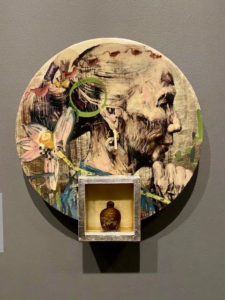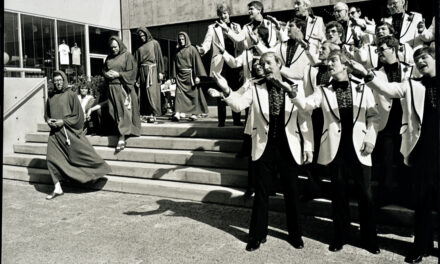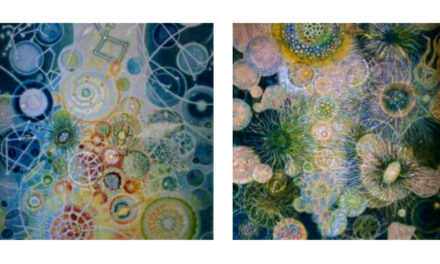(Above: Detail from one of Hung Liu’s many murals, part of the Remember This: Hung Liu at Trillium exhibit at the Jordan Schnitzer Museum of Art)
By Randi Bjornstad
One of the more breathtaking exhibits at the University of Oregon’s Jordan Schnitzer Museum of Art without a doubt is the work by Chinese artist Hung Liu in a show called Remember This: Hung Liu at Trillium.
The saddest thing about this fabulous collection of work is that there won’t be any more of it — Liu died of pancreatic cancer on Aug. 7, 2021 at age 73, less than three weeks before another major collection of her work — titled Hung Liu: Portraits of Promised Lands — opened in the National Portrait Gallery in Washington, D.C., where she was the first Asian-American woman to have a solo show.
But thanks to Liu’s artistic collaboration with printmaker David Salgado, “I think we won the art lottery,” Anne Rose Kitagawa, chief curator of collections and Asian art at the JSMA, said. “They donated their legacy collection to us, and it is an amazing body of work.”
Remember This, which will be on display through Aug. 28, occupies not only the Soreng and Barker galleries at the art museum, but additional pieces also are juxtaposed throughout with other examples of Asian art and even in the museum entrance.
“There are pieces all over — to see them all, you really have to go through the whole museum,” Kitagawa said. “She was such a presence — warm, fascinating, open, gregarious — really beloved. She did at least three lifetimes of work in one.”
This show “is really an exhibition of jewels,” she said, “It is so stunning — she was such a star.”
Like Liu, Salgado also is no longer living. He died on Oct. 20, 2018, at age 69.
The subject matter in Liu’s paintings varied widely, from portraits to landscapes to still life. At the same time, they reflected the experiences and observations of her own life, expressing her interest in social justice, history, migration, and sensitivity to society’s most oppressed people, especially women and children.
All of this grew out of her birth and upbringing in China. She was born in 1948 in Changchun, Jilin province, the year before the Chinese Revolution that brought Mao Zedong and the Chinese Community Party to power. When she was very young, her father was imprisoned in a labor camp, and she moved with her mother to the capital, Beijing.
After she completed high school, Hung Liu was sent to the countryside for four years, where she lived and worked in the agricultural community alongside Chinese peasants as part of the Communist government’s re-education program for privileged youth.
After that stint, she studied mural painting at the Central Academy of Fine Arts and pursued a teaching degree at Beijing Teachers College. She also hosted a television program to teach viewers how to do their own art.
In 1984, Liu came to the United States, where she studied art at the University of California San Diego. She went on to teach at Mills College, a prestigious women’s liberal arts college in Oakland, Calif., retiring in 2014 after 24 years there.
By 2003, Liu had begun her collaboration with master printmaker David Salgado, who had founded Trillium Graphics in Brisbane, south of San Francisco on the west side of the Bay.
The two created their own process for combining her painting and his printmaking, using photographic prints of elements of her paintings, to which she had added additional painted motifs, textures, and in some cases sculptural pieces. After all that, the pieces were embedded in layer upon layer of translucent resin.
After 15 years of working together, they had created more 55 such works that exemplified their singular hybrid technique, and it is that collection of work that they donated in 2018 to the Schnitzer art museum at the UO.

Full Circle, a painting by Hung Liu, representing her artistic interest in the women of her native China
As curator, Kitagawa organized the Remember This exhibit in thematic groups, representing traditional Chinese art, Chinese history, women, children, migration, crisis, and death, many aspects of which had affected Liu’s own life.
“When she was sent to the countryside, she had her own camera, and she took lots of photos, but most were not processed until many year later, and she used many as the basis of her art,” Kitagawa said.
In one case, Liu came across a series of photographs of Chinese prostitutes taken by a Chinese photographer, and she used those as the foundation of one of her most meaningful series, Kitagawa said.
“As a woman herself, she could do that with both sensitivity and understanding,” she said, “Those paintings are unabashedly beautiful, and she really lifts those women up and confers personhood on them.”
But that was one of Liu’s most important characteristics no regardless of subject, she said, “and it is just unfathomable to me that she died so soon after her diagnosis — she was still painting pretty much every day.”
Her skill and artistic contribution was so widespread that after her death, she merited a significant paean in the New York Times that included a photograph of one of her paintings based on one of many photographs of women and children taken by Dorothea Lange during the Great Depression.
One of those paintings is on display in the entrance to the UO’s Remember This show at the Schnitzer art museum.
“She was very interested in the ways that images of the Great Depression reminded her of the poverty and deprivation she had witnessed during her years of working in the fields in China in her youth,” Kitagawa said. “She had so much feeling for people, and everybody loved her, and they loved her work.
“To me, Hung Liu really is an artist for the ages.”
Remember This: Hung Liu at Trillium
When: Through Aug. 28, 2022
Where: Jordan Schnitzer Museum of Art, 1430 Johnson Lane, University of Oregon campus
Hours: 11 a.m. to 7:30 p.m. Wednesday, 11 a.m. to 4:30 p.m. Thursday through Saturday
Admission: $5 adults, $3 pages 62+, free to students, UO staff and children
Information: 541-346-3027 or jsma.uoregon.edu










